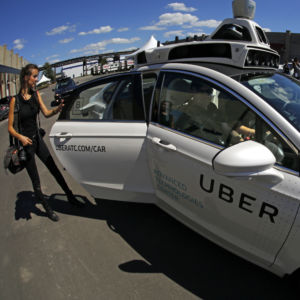Taxi and truck driver unions could soon take a direct hit to their membership as new technologies threaten to replace professional drivers with robots.
Several leading tech companies have been at the forefront of designing automated cars. They still face plenty of logistical and safety concerns but the technology is progressing quickly. Taxi and truck driver unions could start seeing their members replaced by computers when the technology starts to transition to real world use.
“Automation is something anybody who works in or gets income from the transportation sector should be aware of and should be thinking about,” Stanford Law School Scholar Bryant Walker Smith told InsideSources. “There will be profound changes. There will be some opportunities but a lot of challenges for those employed.”
Smith adds the upcoming technology is something unions should be concerned about. Labor unions are particularly vulnerable because their influence is based on membership. When drivers start being replaced by computers, it will mean fewer members that taxi and trucking unions can rally or collect dues from.
“There’s no certainties but I wouldn’t recommend someone become a professional driver and make a career out of that,” Rand Corporation Scholar James Anderson told InsideSources. “I think, pretty clearly, the long-term vision is to get rid of the driver and make that person unnecessary.”
The federal government is even getting behind the bleeding-edge technology, at least to an extent. The government is looking to regulate the industry but it is not outright denying it. The National Highway Traffic Safety Administration released a set of rules Tuesday on how to safely test driverless cars.
“Automation generally is going to bring a whole lot of employment disruption and that’s not limited in any way just to transportation,” Smith stated. “But transportation is going to be particularity prominent because it’s something we can interact with every day.”
Driverless technology is developing quickly but it’s still unclear how long until it’s in regular use. Developers have to remain conscientious of engineering obstacles, regulations and especially safety. It’s also something that will likely not be deployed in every city straightaway.
“Uber is not serving every city right now,” Smith noted. “Uber has identified those markets where it makes the most sense to operate. Likewise in automated driving, the developers and deployers will likely identify those conditions in which early deployment makes the most technical and financial sense.”
Anderson notes the technology could be a threat to existing employment within five years. Nevertheless, he adds the threat will likely be limited at first. Anderson notes it could take upwards of 25 years before driverless technology is perfected and able to operate anywhere.
“If you’re talking about a car that can drive most places, most of the time, without human interaction, arguably we already have that or close to it,” Anderson argued. “In the long term, you can see reduced employment.”
Princeton University Professor Henry Farber isn’t as concerned about the driverless cars hurting employment. He notes it’s likely going to be a while before the technology poses a huge threat to professional drivers. He adds that truck drivers will likely face more problems compared to taxis when the technology finally does come.
“The people that have suffered are not so much the drivers of the taxis but the owner of the capital,” Farber said. “[For] intercity trucking, an awful lot of that is individuals who own their trucks and drive them under contract or on a per load basis for other companies.”
Farber adds taxi drivers will likely find it easier to transition to new fields. Taxi drivers invest less in their jobs and are generally not paid a whole lot anyways. Truck drivers, in contrasts, usually own and operate their trucks and invest a lot of money into their careers.
“These are relatively low-paying and difficult jobs that the taxi drivers have not invested a tremendous amount in,” Farber stated. “Presumably the drivers will move to other occupations and do other things. For many people, taxi driving is a transition occupation.”
Smith notes the new technologies highlight an even greater challenge. Employees in a multitude of industries are facing a rise in technology that could lead to them being replaced by computers. Employers are now less worried about the line that separates capital from labor.
“The fundamental challenge we’re going to face is what do we do with labor when capital and labor are essentially interchangeable,” Smith said. “When companies aren’t limited by who they can hire but by the robots they can make and where that leaves the rest of us. I don’t know what role unions will play in that.”
Farber adds most taxi drivers aren’t even unionized to begin with. Taxi drivers are typically contractors meaning they get fewer union protections and benefits compared to traditional employees. The National Taxi Workers’ Alliance, for instance, became the first nontraditional workforce to become an affiliate of the AFL-CIO.
“For the most part, taxi cab drivers and not employees and are not recognized by unions,” Farber noted. “There are some unions out there that have taxi drivers as members but as far as I can tell, they’re not negotiating contracts with employers.”
In general, union membership has been in sharp decline nationwide over the decades. Federal administrators have issued rules with the express purpose of preserving unions and the older laws. Labor Secretary Thomas Perez, among others, has argued that building upon the existing regulatory system is critical to preserving worker rights.

